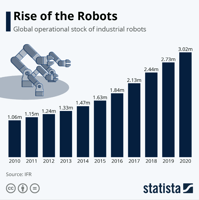From its beginning as a relatively simple machine to help people transport heavy equipment to the...
Looking at Warehouse Automation: The Benefits of Robotics and "Cobotics"
The robotics market has been growing for years. That’s hardly surprising given the variety of tasks robots can handle and the demand for supplementing human effort. Robotics applications generally limited to industrial usage in its infancy, have expanded to applications such as personal assistants, surgical assistants, autonomous vehicles, delivery vehicles, crewless aerial vehicles, and exoskeletons. Valued at USD 24 billion, in 2020, the robotics market could reach USD 74 billion by 2026 quite realistically.
One of the first obstacles to expansion of robot technology was the price tag. Only the largest companies could afford to deploy them. They understood that the return on investment for these machines could take decades. However, with the interest and demand for robotic applications in other industries, smaller collaborative robots began to hit the market with an ROI that could be achieved in months, rather than decades. Many of the smaller, cheaper robots cost about $20,000. Increased adoption, along with steadily declining sensor prices, have helped keep the smaller robots affordable for more businesses.
Moreover, technological innovation and enhancements such as machine learning/artificial intelligence, manipulation, and human interaction have facilitated market growth, especially in consumer goods manufacturing, food processing and packaging, and e-commerce supply chain automation. Here, we explore trends in warehouse automation with robotics and “cobotics.” Before we do that, we should define the term “cobotics.” Simply speaking, a cobot is a robot with the capability of human interaction in a shared space or in close proximity to a human. Traditional robotic applications operate in the absence of (i.e., in isolation from) close human contact. Cobot operation generally incorporates various safety features like lightweight construction materials, rounded edges, limited speed and force, and sensors and software to ensure safe operation.
Service robots and exoskeletons are good examples of cobots. They might provide information in public spaces, transport materials within a building (logistics cobots), load parts for assembly operations, or augment human abilities. Human augmentation enhances/exceeds the natural cognitive and physical abilities of people through integrated technology. Examples are cochlear implants to increase sensory perception and orthotics that enhance motion or muscle capability. Some researchers are even working on data-connecting devices that would link the human body to visual/text-based sources of information. The notion of a metal “skin” with motors to enhance human strength far beyond normal capability once science fiction, now is “science fact” (for more information on Cobots and IFR classifications, click here).
While many may fear that warehouse robots will replace workers, the addition of automated systems in warehousing and manufacturing will improve safety and transition much of the “heavy” lifting to cobots under human control and eliminate much of the stress from repetitive tasks. Warehouse robotics have demonstrated ability to reduce labor costs, improve the efficacy of workflows, and help the bottom line. With labor accounting for up to 65% of the budget in a typical warehouse operation, robotics forklifts have been shown to reduce operating costs by as much as 70%. In a 3-shift operation, a positive ROI may be achievable in 13 months.
“Fetch robots” enable users to control material flow remotely while mitigating the risk of employee injury and increasing efficiency. In most cases, the use of fetch robots require no change in infrastructure. Similarly, “picker robots” can retrieve specific items for shipping and bring them to a central location much faster that humans, something like the Opex Perfect Pick system. The picker function is the most time-consuming of all warehouse functions. With other automated ground vehicle (“AGV”) capabilities like pallet and product transport, robotic arms for assembly and lifting, and barcode scanners for inventory automation, some companies, like Amazon, can promise same-day shipping (much to the delight of their customers).
Robotics applications have begun to address warehouse maintenance, too. For example, the Minuteman Max Ride 20 RoboScrubber has a vision-based artificial intelligence system that enables the robot to navigate complex, real-world warehouse environments to clean the floors. The machine works safely and efficiently alongside employees, and employees have the option to using it in manual mode. Advancements in big data analytics and the Internet of Things offer warehouse operations staff more diverse robotics solutions such as engaging sensor robots for fleet management/tracking in real time, and the ability to make data-driven decisions that improve overall performance from understanding where the bottlenecks are.
As innovation persists in the robotics and cobotics industry, spurred on by the need many companies embrace to keep one step ahead of the competition, by the need to address crises like the COVID pandemic quickly, and by the need to address labor shortages, the growth in the industry could exceed experts’ projections.



